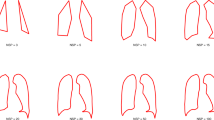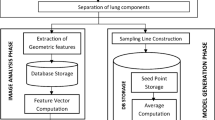Abstract
Accurate information of the lung shape analysis and its anatomical variations is very noticeable in medical imaging. The normal variations of the lung shape can be interpreted as a normal lung. In contrast, abnormal variations of the lung shape can be a result of one of the pulmonary diseases. The goal of this study is twofold: (1) represent two lung shape models which are different at the reference points in registration process considering to show their impact on estimating the inter-patient 2D lung shape variations and (2) using the obtained models in lung field segmentation by utilizing active shape model (ASM) technique. The represented models which showed the inter-patient 2D lung shape variations in two different forms are fully compared and evaluated. The results show that the models along with standard principal component analysis (PCA) can be able to explain more than 95% of total variations in all cases using only first 7 principal component (PC) modes for both lungs. Both models are used in ASM-based segmentation technique for lung field segmentation. The segmentation results are evaluated using leave-one-out cross validation technique. According to the experimental results, the proposed method has average dice similarity coefficient of 97.1% and 96.1% for the right and the left lung, respectively. The results show that the proposed segmentation method is more stable and accurate than other model-based techniques to inter-patient lung field segmentation.













Similar content being viewed by others
References
Sundaram, T.A., B.B. Avants, and J.C. Gee. A dynamic model of average lung deformation using capacity-based reparameterization and shape averaging of lung MR images. in International conference on medical image computing and computer-assisted intervention. 2004. Springer.
Quadros, L.S., R. Palanichamy, and A.S. D'souza, Variations in the lobes and fissures of lungs-a study in South Indian lung specimens. Eur J Anat, 2014. 18(1): p. 16-20.
Hayashi, K., et al., Radiographic and CT appearances of the major fissures. Radiographics, 2001. 21(4): p. 861-874.
Aldur, M., et al., An accessory fissure in the lower lobe of the right lung. Morphologie: Bulletin de l'Association des anatomistes, 1997. 81(252): p. 5-7.
El-Baz, A., et al. 3D shape analysis for early diagnosis of malignant lung nodules. in Biennial International Conference on Information Processing in Medical Imaging. 2011. Springer.
Meenakshi, S., K. Manjunath, and V. Balasubramanyam, Morphological variations of the lung fissures and lobes. Indian Journal of Chest Diseases and Allied Sciences, 2004. 46: p. 179-182.
Le, K. Automated detection of early lung cancer and tuberculosis based on X-ray image analysis. in Proc. WSEAS International Conference on Signal, Speech and Image Processing. 2006.
Yan, Z., et al. Automatic Rapid Segmentation of Human Lung from 2D Chest X-Ray Images. in Proc. of MICCAI workshop on Sparsity Techniques in Medical Imaging. 2012.
Wu, Y.C., K. Doi, and M.L. Giger, Detection of lung nodules in digital chest radiographs using artificial neural networks: a pilot study. Journal of Digital Imaging, 1995. 8(2): p. 88.
Zhang, D. and G. Lu, Review of shape representation and description techniques. Pattern recognition, 2004. 37(1): p. 1-19.
Afzali, A., F.B. Mofrad, and M. Pouladian, Inter-Patient Modelling of 2D Lung Variations from Chest X-Ray Imaging via Fourier Descriptors. Journal of medical systems, 2018. 42(11): p. 233.
Shen, L., et al., A surface-based approach for classification of 3D neuroanatomic structures. Intelligent Data Analysis, 2004. 8(6): p. 519-542.
Huang, H., et al. Surface alignment of 3D spherical harmonic models: Application to cardiac MRI analysis. in International Conference on Medical Image Computing and Computer-Assisted Intervention. 2005. Springer.
Cosgriff, R., Identification of shape, Ohio State Univ. Res. Foundation, Columbus, Rep, 1960: p. 820-11.
Zhang, G., et al. Shape feature extraction using Fourier descriptors with brightness in content-based medical image retrieval. in 2008 International Conference on Intelligent Information Hiding and Multimedia Signal Processing. 2008. IEEE.
Afzali, A., F.B. Mofrad, and M. Pouladian, Contour-based lung shape analysis in order to tuberculosis detection: modeling and feature description. Medical & biological engineering & computing, 2020. 58(9): p. 1965-1986.
Candemir, S. and S. Antani, A review on lung boundary detection in chest X-rays. International journal of computer assisted radiology and surgery, 2019. 14(4): p. 563-576.
Klinder, T., C. Lorenz, and J. Ostermann. Prediction framework for statistical respiratory motion modeling. in International Conference on Medical Image Computing and Computer-Assisted Intervention. 2010. Springer.
Zhang, S., et al., Towards robust and effective shape modeling: Sparse shape composition. Medical image analysis, 2012. 16(1): p. 265-277.
Li, X., et al., Automatic lung field segmentation in x-ray radiographs using statistical shape and appearance models. Journal of Medical Imaging and Health Informatics, 2016. 6(2): p. 338-348.
Lopes, U. and J.F. Valiati, Pre-trained convolutional neural networks as feature extractors for tuberculosis detection. Computers in biology and medicine, 2017. 89: p. 135-143.
Gang, P., et al. Dimensionality reduction in deep learning for chest x-ray analysis of lung cancer. in 2018 tenth international conference on advanced computational intelligence (ICACI). 2018. IEEE.
Cheimariotis, G.-A., et al., Automatic lung segmentation in functional SPECT images using active shape models trained on reference lung shapes from CT. Annals of nuclear medicine, 2018. 32(2): p. 94-104.
Gordienko, Y., et al. Deep learning with lung segmentation and bone shadow exclusion techniques for chest x-ray analysis of lung cancer. in International Conference on Computer Science, Engineering and Education Applications. 2018. Springer.
Nakao, M., et al., Surface deformation analysis of collapsed lungs using model-based shape matching. International journal of computer assisted radiology and surgery, 2019. 14(10): p. 1763-1774.
Souza, J.C., et al., An automatic method for lung segmentation and reconstruction in chest X-ray using deep neural networks. Computer methods and programs in biomedicine, 2019. 177: p. 285-296 %@ 0169-2607.
Gaál, G., B. Maga, and A. Lukács, Attention u-net based adversarial architectures for chest x-ray lung segmentation. arXiv preprint, 2020.
Usman, M., et al., Volumetric lung nodule segmentation using adaptive roi with multi-view residual learning. Scientific Reports, 2020. 10(1): p. 1-15.
Candemir, S., et al., Lung segmentation in chest radiographs using anatomical atlases with nonrigid registration. IEEE transactions on medical imaging, 2013. 33(2): p. 577-590.
Jaeger, S., et al., Automatic tuberculosis screening using chest radiographs. IEEE transactions on medical imaging, 2013. 33(2): p. 233-245.
Shiraishi, J., et al., Development of a digital image database for chest radiographs with and without a lung nodule: receiver operating characteristic analysis of radiologists' detection of pulmonary nodules. American Journal of Roentgenology, 2000. 174(1): p. 71-74.
Van Ginneken, B., M.B. Stegmann, and M. Loog, Segmentation of anatomical structures in chest radiographs using supervised methods: a comparative study on a public database. Medical image analysis, 2006. 10(1): p. 19-40.
Tomakova, R., et al., The Use of Fourier Descriptors for the Classification and Analysis of Peripheral Blood Smears Image. Applied Mathematics, 2017. 8(11): p. 1563-1571.
Shen, L., H. Farid, and M.A. McPeek, Modeling three‐dimensional morphological structures using spherical harmonics. Evolution: international journal of organic evolution, 2009. 63(4): p. 1003-1016.
Zhang, D. and G. Lu. A comparative study on shape retrieval using Fourier descriptors with different shape signatures. in Proc. of international conference on intelligent multimedia and distance education (ICIMADE01). 2001.
Persoon, E. and K.-S. Fu, Shape discrimination using Fourier descriptors. IEEE Transactions on systems, man, and cybernetics, 1977. 7(3): p. 170-179.
Ehrhardt, J., et al., Statistical modeling of 4D respiratory lung motion using diffeomorphic image registration. IEEE transactions on medical imaging, 2010. 30(2): p. 251-265.
Stegmann, M.B. and D.D. Gomez, A brief introduction to statistical shape analysis. Informatics and mathematical modelling, Technical University of Denmark, DTU, 2002. 15(11).
Shen, L., et al. Hippocampal shape analysis: surface-based representation and classification. in Medical Imaging 2003: Image Processing. 2003. International Society for Optics and Photonics.
Davies, R.H., Learning shape: optimal models for analysing natural variability. 2002: University of Manchester Manchester.
Lamecker, H., T. Lange, and M. Seebass. A statistical shape model for the liver. in International conference on medical image computing and computer-assisted intervention. 2002. Springer.
Wang, J. and C. Shi, Automatic construction of statistical shape models using deformable simplex meshes with vector field convolution energy. Biomedical engineering online, 2017. 16(1): p. 49.
Pietka, E., Lung segmentation in digital radiographs. Journal of digital imaging, 1994. 7(2): p. 79-84.
Behiels, G., et al. Active shape model-based segmentation of digital X-ray images. in International Conference on Medical Image Computing and Computer-Assisted Intervention. 1999. Springer.
Tobon-Gomez, C., et al., Automatic training and reliability estimation for 3D ASM applied to cardiac MRI segmentation. Physics in Medicine & Biology, 2012. 57(13): p. 4155.
Schneiter, F., Lip Contour Localization using Statistical Shape Models. 2009, Master Thesis Supervised by Gabriele Fanelli Computer Vision Institute ….
Yu, P., et al., An automatic computer-aided detection scheme for pneumoconiosis on digital chest radiographs. Journal of digital imaging, 2011. 24(3): p. 382-393.
Cootes, T.F., et al., Active shape models-their training and application. Computer vision and image understanding, 1995. 61(1): p. 38-59.
Cootes, T., E. Baldock, and J. Graham, An introduction to active shape models. Image processing and analysis, 2000: p. 223-248.
Van Ginneken, B., et al., Active shape model segmentation with optimal features. IEEE transactions on medical imaging, 2002. 21(8): p. 924-933.
Lamecker, H., T. Lange, and M. Seebass, Segmentation of the liver using a 3D statistical shape model. 2004.
Hamarneh, G., P. Jassi, and L. Tang. Simulation of ground-truth validation data via physically-and statistically-based warps. in International Conference on Medical Image Computing and Computer-Assisted Intervention. 2008. Springer.
Shi, Y., et al., Segmenting lung fields in serial chest radiographs using both population-based and patient-specific shape statistics. IEEE Transactions on medical Imaging, 2008. 27(4): p. 481-494.
Hooda, R., A. Mittal, and S. Sofat, Segmentation of lung fields from chest radiographs-a radiomic feature-based approach. Biomedical engineering letters, 2019. 9(1): p. 109-117.
Xu, T., et al., An edge-region force guided active shape approach for automatic lung field detection in chest radiographs. Computerized Medical Imaging and Graphics, 2012. 36(6): p. 452-463.
Juhász, S., et al. Segmentation of anatomical structures on chest radiographs. in XII Mediterranean Conference on Medical and Biological Engineering and Computing 2010. 2010. Springer.
Kroon, D.-J., Active shape model (ASM) and active appearance model (AAM). MATLAB implementation, www.mathworks.com/matlabcentral/fileexchange/26706-active-shape-model-asm-and-active-appearance-model-aam, 2010. 8: p. 22.
Oliveira, H. and J. dos Santos. Deep transfer learning for segmentation of anatomical structures in chest radiographs. in 2018 31st SIBGRAPI Conference on Graphics, Patterns and Images (SIBGRAPI). 2018. IEEE.
Arbabshirani, M.R., et al. Accurate segmentation of lung fields on chest radiographs using deep convolutional networks. in Medical Imaging 2017: Image Processing. 2017. International Society for Optics and Photonics.
Author information
Authors and Affiliations
Corresponding author
Ethics declarations
Ethical Approval
This article does not contain any studies with human participants or animals performed by any of the authors.
Conflict of Interest
The authors declare that they have no conflict of interest.
Additional information
Publisher's Note
Springer Nature remains neutral with regard to jurisdictional claims in published maps and institutional affiliations.
Rights and permissions
About this article
Cite this article
Afzali, A., Babapour Mofrad, F. & Pouladian, M. 2D Statistical Lung Shape Analysis Using Chest Radiographs: Modelling and Segmentation. J Digit Imaging 34, 523–540 (2021). https://doi.org/10.1007/s10278-021-00440-7
Received:
Revised:
Accepted:
Published:
Issue Date:
DOI: https://doi.org/10.1007/s10278-021-00440-7




